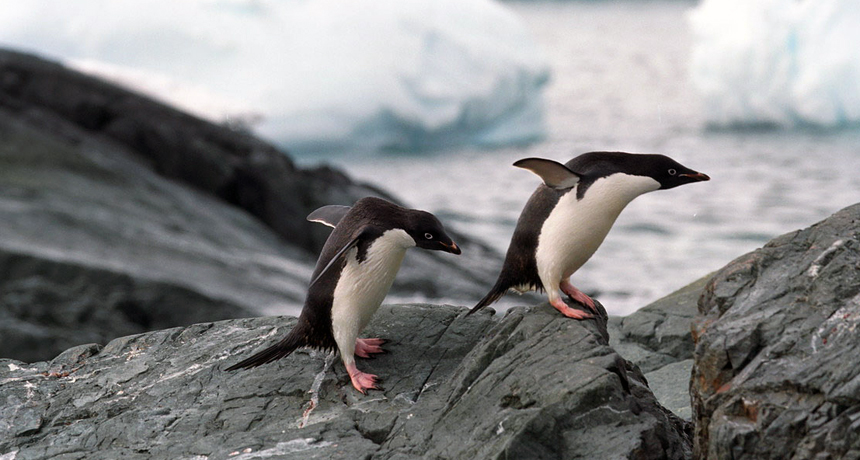Even penguins get the flu
It’s not known, however, whether the virus makes these birds very sick

Flu infections have hit Adélie penguins in Antarctica, like those shown here. The virus responsible for the infections appears to have evolved into a form unique to the most southern continent.
Jerzy Strzelecki/Wikimedia Commons (CC BY 3.0)
By Janet Raloff
Scientists have uncovered bird flu germs in Adélie penguins in Antarctica. The virus didn’t infect many of those birds. But it is so unlike other flu viruses that biologists think it may have been evolving in isolation for decades. That has turned it into a distinctly Antarctic germ.
Bird flu viruses tend to be widely dispersed around the globe. And no wonder. Migratory birds can carry these viruses wherever they fly. Many of these long-distance travelers can migrate between two or more continents.
Sometimes a flu virus that infects birds will sicken them. Other times, birds pick up an infection but develop no symptoms. All infected birds do, however, shed the virus in their feces. Other members of close-knit bird colonies may step in those feces. Or the feces can get washed into water. So bird flu can spread widely and in many directions over long distances. That happens even when there aren’t a lot of visibly sick birds. Along the way, other animals, including marine mammals, may also pick up the germs.
Recently, biologists reported finding flu antibodies in penguins. The presence of antibodies indicated that the birds had at one time been exposed to a virus. But such studies didn’t show whether infections were ongoing in the penguins.
The new study was conducted by Aeron Hurt, a virus researcher at an international flu research center in North Melbourne, Australia, and his colleagues. They collected blood and throat germs from about 300 Adélie penguins — both adults and chicks — in Antarctica. The scientists sampled virus from the birds during January and February 2013. That was summer on the far southern continent.
A few penguins hosted “live” virus — a form that is infective. It belonged to a bird flu family known as H11N2. No infected penguin looked sick or underweight. Still, the presence of the virus showed some of the birds were harboring an active infection.
To better gauge where the germ might have come from, the scientists compared genes from it against the genes in other types of bird-flu viruses. The genes from flu in the few infected penguins were nearly identical. But those viruses had quite different genes from bird viruses circulating elsewhere in the world. That suggests the penguins’ virus was not a recent arrival. It was not, for instance, a germ picked up a continent away and dropped off last year by a migrating visitor, the scientists say.
In fact, they noted, the penguins’ virus was so different that it may have been evolving in Antarctica — in near isolation — for between 49 and 80 years. Hurt’s group reported its findings online May 6 in the journal mBio.
Antarctica, the authors posit, may be “the most extreme example” of a localized evolutionary sink for bird flu viruses. Such a sink would be a place where viruses arrive from elsewhere, now and again. Once established, those viruses could then evolve independently from flu germs elsewhere around the globe.
Power Words
Antarctica A continent mostly covered in ice, which sits in the southernmost part of the world.
antibody Any of a large number of proteins that the body produces as part of its immune response. Antibodies neutralize, tag or destroy viruses, bacteria and other foreign substances in the blood.
evolutionary An adjective that refers to changes that occur within a species over time as it adapts to its environment. Such evolutionary changes usually reflect genetic variation and natural selection, which leave a new type of organism better suited for its environment than its ancestors. The newer type is not necessarily more “advanced,” just better adapted to the conditions in which it developed.
evolve To change gradually over generations, or a long period of time. In living organisms, the evolution usually involves random changes to genes that will then be passed along to an individual’s offspring. These can lead to new traits, such as altered coloration, new susceptibility to disease or protection from it, or different shaped features (such as legs, antennae, toes or internal organs).
germ Any one-celled microorganism, such as a bacterium, fungal species or virus particle. Some germs cause disease. Others can promote the health of higher-order organisms, including birds and mammals. The health effects of most germs, however, remain unknown.
infection A disease that can be transmitted between organisms.
influenza (or flu) A highly contagious viral infection of the respiratory passages causing fever and severe aching. It often occurs as an epidemic.
migratory Individuals (people or animals) that move from one region or habitat to another, especially regularly and according to the seasons.
sink (in biology) A pool of organisms that accumulate in one general region, from which they can later expand outward, migrating to new sites.
virus Tiny infectious particles consisting of RNA or DNA surrounded by protein. Viruses can reproduce only by injecting their genetic material into the cells of living creatures. Although scientists frequently refer to viruses as live or dead, in fact no virus is truly alive. It doesn’t eat like animals do, or make its own food the way plants do. It must hijack the cellular machinery of a living cell in order to survive.







